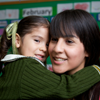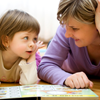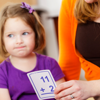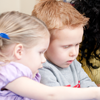
About inCLASS: Dimensions
The inCLASS measures children's interactions within 3 broad domains. Within each domain, there are specific dimensions.
Teacher Interactions
Positive Engagement With Teacher
 Measures the degree to which the child is emotionally connected to the teacher(s) and adults, including seeking and enjoying interactions with them, and using them as a secure base.
Measures the degree to which the child is emotionally connected to the teacher(s) and adults, including seeking and enjoying interactions with them, and using them as a secure base.
Teacher Communication
 Measures the degree to which the child initiates and maintains conversation with the teacher(s) and adults while using language as a functional tool to make needs, emotions, and opinions known (e.g., requesting, commenting, and questioning).
Measures the degree to which the child initiates and maintains conversation with the teacher(s) and adults while using language as a functional tool to make needs, emotions, and opinions known (e.g., requesting, commenting, and questioning).
Teacher Conflict
 Measures the degree to which the child's interactions with the teacher(s) and adults are characterized by tension, resistance, and negativity.
Measures the degree to which the child's interactions with the teacher(s) and adults are characterized by tension, resistance, and negativity.
Peer Interactions
Peer Sociability
 Measures the degree to which the child experiences positive emotions and behaviors with other children, including the tendency to seek peer interactions, show social awareness and respond in a manner that peers react positively to.
Measures the degree to which the child experiences positive emotions and behaviors with other children, including the tendency to seek peer interactions, show social awareness and respond in a manner that peers react positively to.
Peer Communications
 Measures the degree to which the child initiates and maintains conversation with other children while using language as a functional tool to make needs, emotions, and opinions known (e.g., requesting, commenting, and questioning).
Measures the degree to which the child initiates and maintains conversation with other children while using language as a functional tool to make needs, emotions, and opinions known (e.g., requesting, commenting, and questioning).
Peer Assertiveness
 Measures the degree to which the child uses positive strategies to initiate and lead interactions with other children, and the degree to which those strategies are successful.
Measures the degree to which the child uses positive strategies to initiate and lead interactions with other children, and the degree to which those strategies are successful.
Peer Conflict
 Measures the degree to which the child's interactions with other children are characterized by tension, resistance, and negativity.
Measures the degree to which the child's interactions with other children are characterized by tension, resistance, and negativity.
Task Orientation
Engagement Within Tasks
 Measures the degree to which the child is consistently and actively involved in classroom tasks and activities, including the amount of time the child remains focused on any given activity, the level of intensity or enthusiasm displayed, and the proportion of time the child spends on assigned activities..
Measures the degree to which the child is consistently and actively involved in classroom tasks and activities, including the amount of time the child remains focused on any given activity, the level of intensity or enthusiasm displayed, and the proportion of time the child spends on assigned activities..
Self-Reliance
 Measures the degree to which the child takes learning into their own hands, including seeking opportunities rather than passively waiting for teacher direction, and making best use of classroom resources (including the teacher).
Measures the degree to which the child takes learning into their own hands, including seeking opportunities rather than passively waiting for teacher direction, and making best use of classroom resources (including the teacher).
Behavior Control
 Measures the degree to which the child regulates movement, physical activity, and verbalizations, so that these match the expectations of the setting.
Measures the degree to which the child regulates movement, physical activity, and verbalizations, so that these match the expectations of the setting.